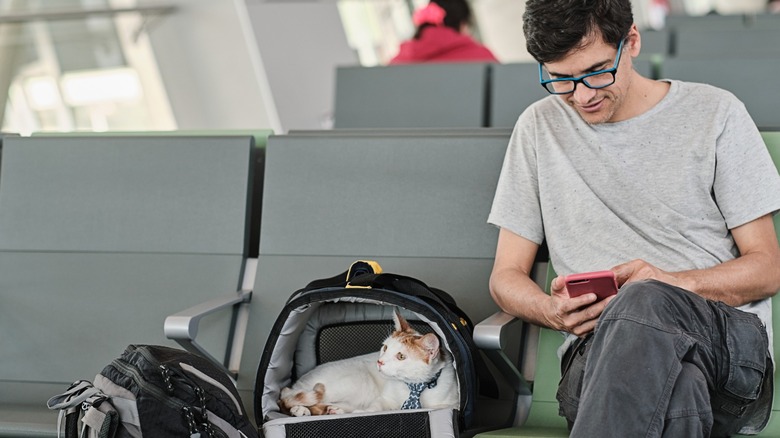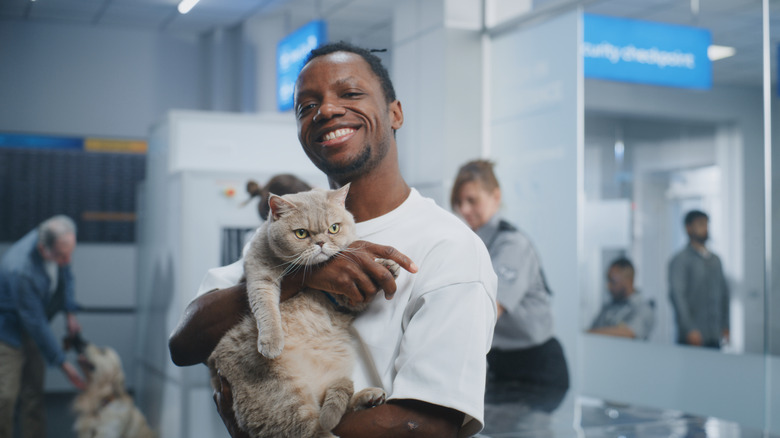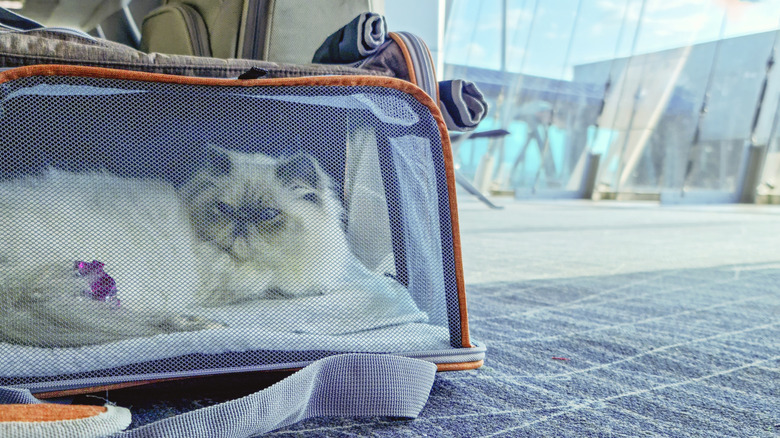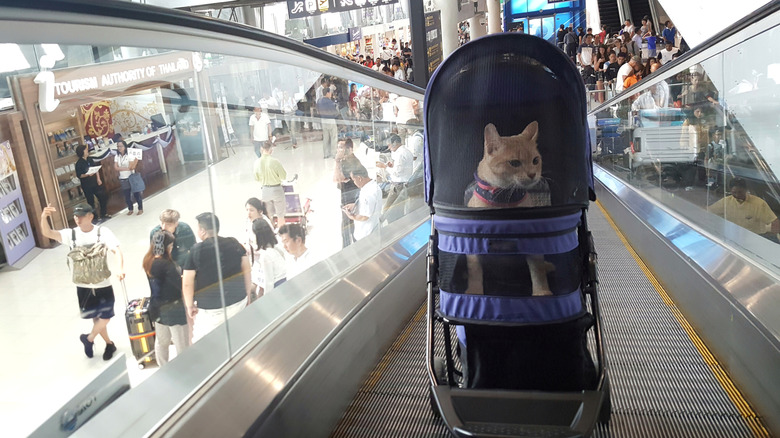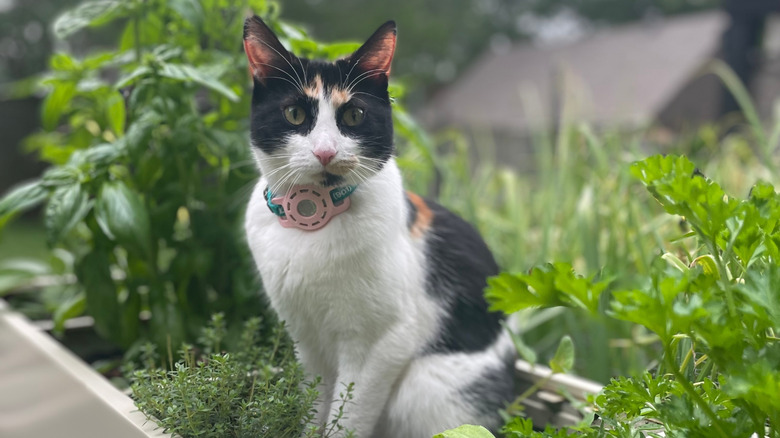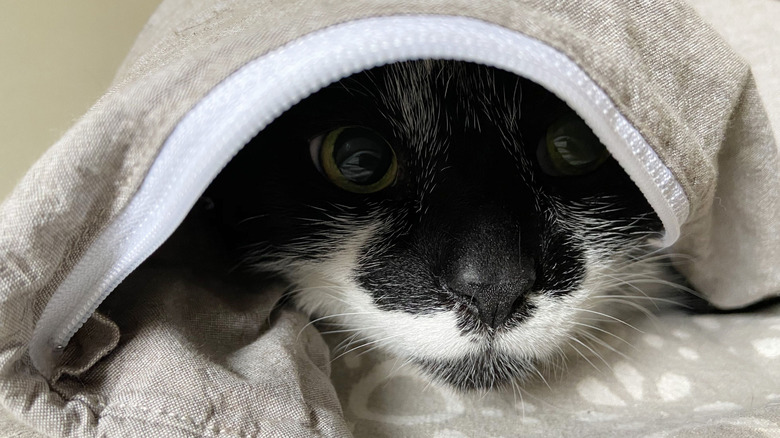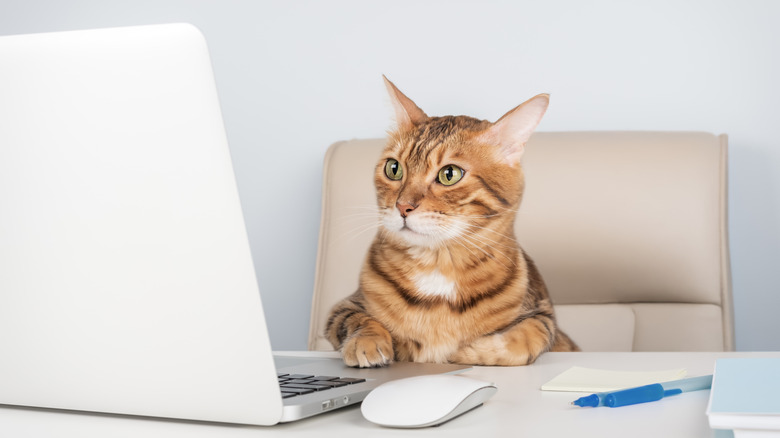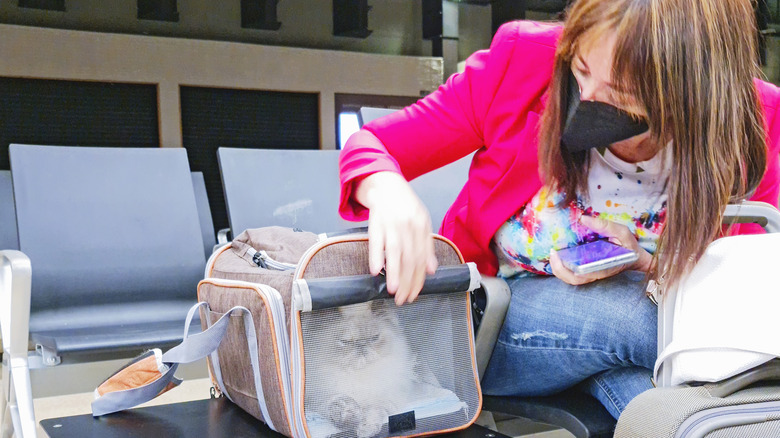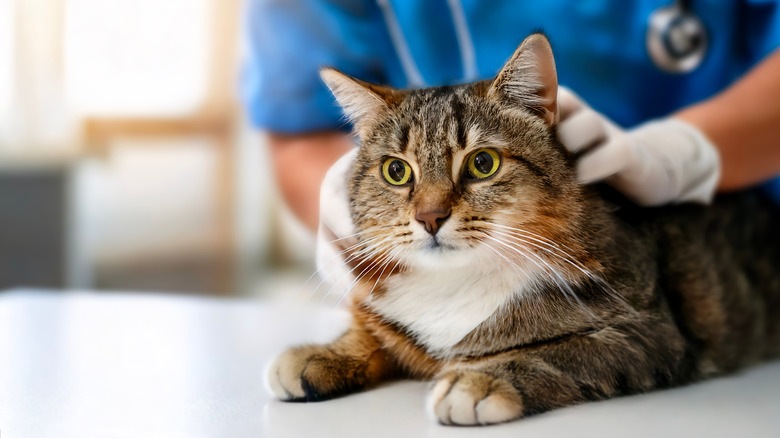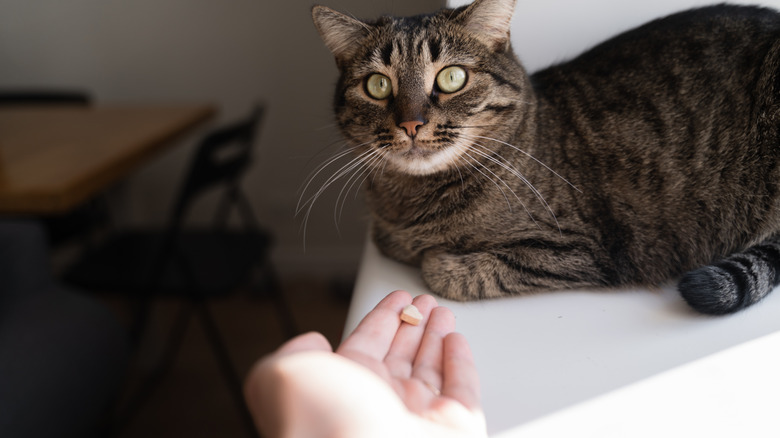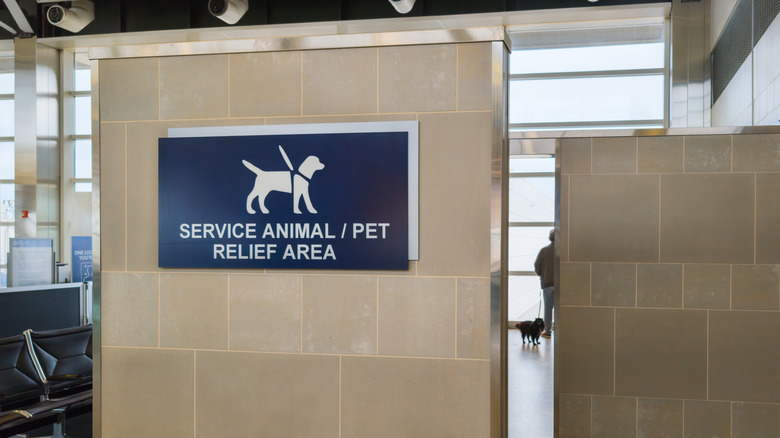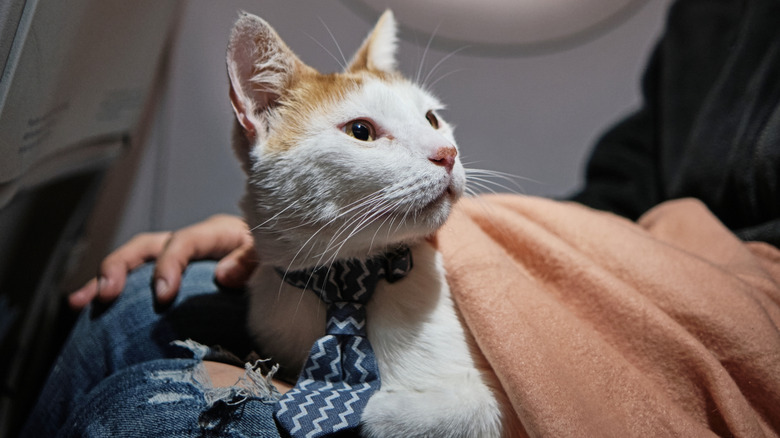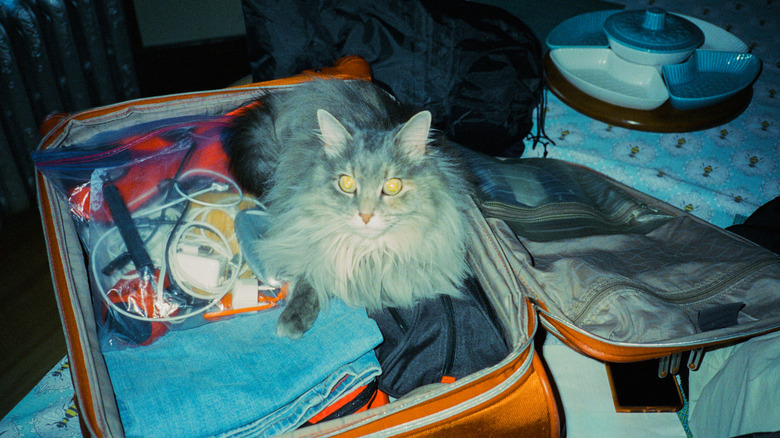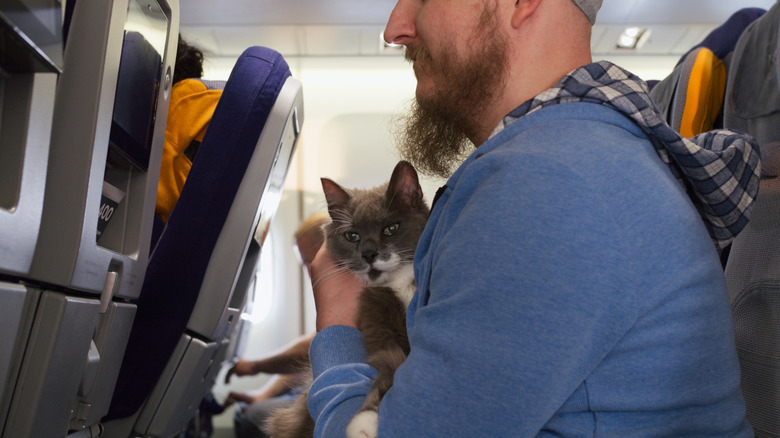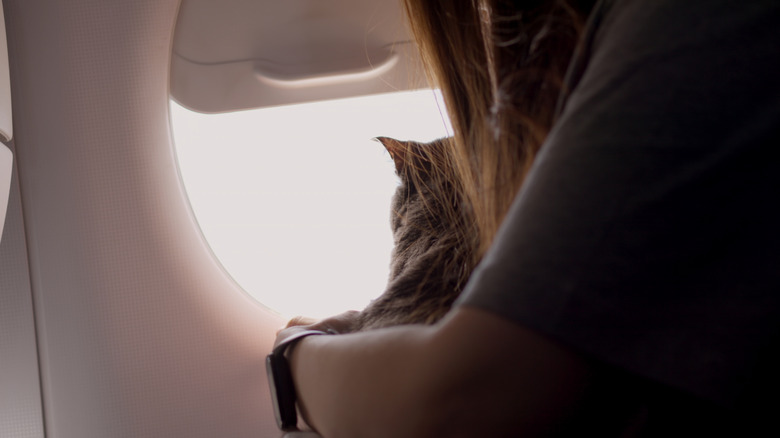Game-Changing Tips From Pet Parents To Make Plane Travel With Your Cat As Smooth As Possible
We may receive a commission on purchases made from links.
As cat moms and dads, we want to do everything we can to keep the owners of our favorite little jellybeans happy, from ear scritches to maintaining a steady supply of the purrfect treats. And that means avoiding common pet travel mistakes and making sure our fur babies are as comfortable as possible when we travel by air. The good news is that there's never been a better time to take to the skies with your bewhiskered family since most airlines and airports have vastly improved their accommodations for furry travelers and their families over the past couple of decades.
Whether you're traveling with an emotional support kitty or just your purry best friend, airport pet zones and knowledgeable staff are there to help things go more smoothly. Even better, other pet parents are notoriously helpful when it comes to sharing the fruits of their own experience to help other cat ladies and gents experience smooth sailing in the friendly skies. From the travel planning phase to ensuring mid-flight comfort, here's a comprehensive list of experienced cat parent advice for keeping your favorite little floof purrrfectly peaceful next time you fly together.
Request a private security screening
Whereas dogs tend to be people lovers, making airport security screenings just another big friendly adventure, cats tend to be a lot more suspicious about folks they don't know. And that can make going through airport security hard on all involved parties since those little fluff nuggets tend to come with some pretty serious murder mittens. As the saying goes, these cats have claws.
That's because even if your favorite meowster is in a kitty carrier, TSA rules require temporarily removing them so their kitty Uber can get X-rayed. And suddenly finding themselves in a strange space surrounded by unfamiliar humans on all sides can transform even the most loving potato kitties into danger floofs. To avoid this debacle, most airports will happily arrange a private security screening for you and your travel buddy upon request, making the whole experience far less stressful for everyone (especially the cat). This can be requested upon check-in, but it's even better to set it up in advance by calling the TSA Cares Helpline about three to five days ahead of your flight.
When you set up a private screening, you'll walk through the metal detector and then follow an officer of your gender to a private location. Once there, you'll need to remove kitty from her carrier while a second officer takes the carrier to run through the X-ray. Easy!
Invest in a TSA-compliant cat carrier
According to the TSA's guidelines for traveling with small pets, pet carriers need to be able to fit through the X-ray machine. While the TSA doesn't explicitly ban or suggest any specific criteria for the best pet carriers for airplanes, it's best to travel with a soft-sided carrier that will definitely fit through the machine if you end up having to check it.
You also need to make sure your carrier will fit underneath the seat in front of you, which means checking with the airline you're traveling to confirm the dimensions your carrier will need to fit. According to PurplePup Pet Transportation Services (via YouTube), this is typically 18 by 11 by 11 inches. PurplePet also advises that both pet and carrier together should weigh no more than 20 pounds, and that your kitty needs to be able to stand up and turn around while inside. Finally, carriers should be ventilated on three sides so your fur baby can get the fresh air she needs to generate all of those happy purrs you love so much.
Guidelines can vary from one airline to the next, so be sure to contact your airline to ensure you're meeting those requirements. Writing on r/CatAdvice, one Reddit user recalled being forced into a first-class upgrade while flying Delta, warning, "There were literally no carriers I could find that would fit the teeny tiny dimensions of non-first class seats on their plane."
Take a cat harness for security checks
Not everyone can be like feline TikTok sensation Prince Louie of Prince Louie and Todd, who casually hangs on his person's shoulders with nary a pet carrier in sight as the duo passes through TSA security checks without breaking a sweat. For most cats, being subjected to the unfamiliar sights and sounds of the airport could potentially trigger a fight-or-flight situation, especially one where your kitty could end up lost or harmed mid-freakout. That's why a good cat harness is an absolute must, even if you're planning to keep your kitty in her carrier throughout your flight.
Seasoned cat parent travelers suggest investing in a harness that can easily connect to a leash during security checks and litter box breaks without much pomp and circumstance. Reporting on Reddit, one kitty parent advised, "I also have my cats in harnesses (rabbitgoo brand on Amazon) when they travel so I can easily hold them through security without them trying to escape."
Put an AirTag on your cat's travel harness or collar
Even if you're not the kind of pet parent who feels the need to keep a tracker on your cat at home, many kitty owners say sticking an AirTag or similar tracking device on kitty's collar or harness can go a long way in helping them feel secure when traveling together. Think of it as a third line of defense against kitty Houdinis. In fact, a busy airport is almost an ideal space for AirTags since these types of trackers work by connecting with other users' phones, hence why one U.S. airline has even started encouraging AirTag luggage tracker sharing.
In the early days of AirTags, attaching a disc to a kitty collar often meant getting creative with keychains designed to hold AirTags. But these days, pet owners can choose from a wide range of cat collars designed explicitly for this purpose. You can even get them engraved for about the same price as any other fancy collar. Just remember that you'll have to purchase your tracker disc separately and pop it in before taking off.
Bring something that smells like home
Whether you're taking your kitty to the kennel, the vet, or on a cross-country vacation by air, the experience can be pretty stressful on our little snugglepuffs. But like their canine counterparts, folks of the felis catus variety are highly tuned into their sense of smell, thanks in no small part to what's known as a Jacobson (or vomeronasal) organ. Think of it as a highly evolved biomachine in the roof of your cat's mouth that allows her to analyze the chemicals that make up a scent.
With such a highly refined olfactory skillset, it's easy to understand how strange and unfamiliar scents could be discomforting to kitties, especially when they're in an airport surrounded by potentially thousands of unfamiliar humans, pets, and service animals. Since cats mark their territory through behaviors like cheek rubbing and scratching, items from home can carry more familiar scents. In other words, taking the time to pack a blanket or beloved toy that carries the scent of home can go a long way in helping your favorite floof find chill time mid-air. Take it from one r/CatAdvice Reddit user who reported, "I put a thin basket-style cat bed with a little blanket folded up inside our carrier, and my cat ended up burrowing between the two to make himself a nice safe cave."
Research your airline's track record for cats before flying
While it's true that most airports and airlines have made serious strides in terms of welcoming kitties, not everyone got the memo. Since our floofnuggets are family, after all, many cat parents say it's well worth taking the time to make sure the skies you're flying are friendly to everyone, even the furry folks in your party. Just as not every airline has enough floor space for kitty carriers, some airlines have managed to rack up an online reputation for anti-kitty discrimination.
Reporting their experience on one Canadian airline, one r/CatAdvice user warned against using them "at ALL costs" after flying the airline twice. "They are basically terrorists to you about keeping your cat under the seat at all times." Not only were the flight attendants less-than-friendly, but the cat parent reported feeling hostility from them, noting that "every single one of their flight attendants was extremely aggressive to me about even so much as daring to have a cat on board."
It's also a good idea just to research your airline's in-cabin pet policies before traveling. For example, Southwest Airlines' website shares a rather detailed breakdown of their pet policy, including information about their pet fee and any age requirements. Information is power.
Practice for the trip
It might seem a little bit silly or over-the-top, but if you've never traveled with your cat by air, taking kitty out for a test run can go a long way in terms of understanding what you're up against when the big day arrives. After all, learning midflight that your normally docile cat reacts to the pressures of travel with nonstop yowling would be a real cat parent nightmare scenario. And as an added bonus, a trial run gives your kitty experience in the travel pet carrier so they're (hopefully) much less freaked out when you head to the airport.
Writing on r/CatAdvice, one travel-seasoned kitty parent advised taking your cat out in her carrier on short trips before your flight day. Bring along kitty treats, food, and anything else you plan to take when you're flying. As a bonus, bring along her harness and take her out to meet a few strangers while you're adventuring to help prepare her for the security check.
Make sure her shots are up to date
Most airlines explicitly require travelers with pets to bring proof that their vaccinations are up-to-date, but ensuring your pet's jabs are current also helps to keep your kitty and everyone else around her safe. While TSA does not explicitly outline the vaccines required to travel domestically, each airline should have its own requirements. At the same time, not every airline is explicit about what's included in those vaccinations. For example, Southwest Airlines simply states that pets should be "vaccinated," whereas American Airlines' policy appears to require checked pets to come with a health certificate within 10 days of travel, but doesn't go into detail about carry-on pets.
To ensure all of your ducks are in a row, it's best to call and confirm with your airline upon booking your trip. Most importantly, keep your cat's shots up-to-date at all times. And it can't hurt to set up an appointment with your vet to pick up a health certificate ensuring your little purr pal is good to go. Just be sure to pack a copy of your vaccination records and any other health information in your carry-on luggage before heading out.
Get a kitty's little helper from your vet
Every kitty is different. While some meowsters seem to thrive on the adventure, it's not uncommon for cats to find the whole experience altogether rather frightening. And as cat lovers, the last thing we want to see is our furry besties traumatized. Fortunately, your trusty veterinarian should be more than familiar with the right meds for a little kitty cocktail if your floof should prove one of the more sensitive souls of her species.
It should go without saying that you should never attempt to DIY your pet's travel sedation, as it could put your pet's safety at risk. Air travel sedation for pets can be a controversial matter among veterinarians, but most on Reddit tend to agree that mild sedatives are fine for pets riding in the cabin with you. Your family veterinarian will also be familiar enough with your pet's individual health needs to help you make an informed decision that works best for your floofer.
The United States Department of Transportation also advises giving your cat's meds a test run before traveling to avoid learning about any serious reactions while you're already a mile high. That said, always check with your carrier before dosing your kitty since some flight plans don't allow kitty doping and will not knowingly allow you to fly with a sedated pet.
Use the pet relief area before and after each flight
When it comes to pet potty issues, traveling with kitties can be a bit more complicated than it might be for their canine counterparts. But with a little planning, you and your kitty will sail through this travel trial with flying colors. It doesn't have to be mucky business.
Start by investing in the supplies you'll need for your trip. This includes a tinkle pad to tuck away in your carrier because accidents can and do happen, especially on long flights. Pack a few extras in your carry-on to save your kitty the embarrassment if and when she has a mid-flight whoopsie. You'll also want to pick up a portable litter box of some kind.
Albert of YouTube's Albert & Mia, the Adventure Bengal Cat has traveled both domestically and internationally with his tiny tiger. Although he travels with a lightweight collapsible carrier that folds into a bag, stopping by the pet relief area to give her a chance to go before and after the flight, Albert advises that a good old-fashioned package of tin foil can work just as well for a disposable on-the-go litter box. Just don't forget to pack some extra kitty litter and large locking freezer bags, and dispose of everything safely.
Splurge on your seat
If the idea of cramming your best friend under a seat where your feet would normally go for several hours doesn't sit well with you, consider splurging on a seat with a little more room for your own feet. Anytime you travel, the fact that you're already having to shell out for your fur friend is a given, so flying at a higher price point may just be the best solution for your crew. You can never have enough comfort.
And then there's Prince Louie of Prince Louie and Todd, who really sells the whole second seat concept as he's shown casually chilling in his own seat for a five-hour flight. Although most airlines don't technically allow feline seating, it can't hurt to try. If you've got the cash to burn, some flight attendants can be fairly lax about letting cool kitties relax on their owners' laps or even chill out on otherwise open seats. As one Reddit user reported on r/TravelHacks, "On the flight back when they moved back to AZ, nobody was sitting next to me so I sat him in the empty seat."
Pack the right supplies
Just as we homo sapiens sometimes need to pack extra creature comforts to make ultra-long-haul flights more bearable, kitties tend to fare better on flights when they've got all of their creature comforts. Besides any medications, litter supplies, comfort objects, and potty pads, be sure to bring enough food for your cat. If she's not used to flying, it might not be a great idea to feed her while you're traveling, just in case she gets airsick. But even if this isn't an issue or the flight isn't long enough to coincide with her dinner hour, there's no guarantee that your checked bags will end up where you are.
You'll also need a dish for providing your meowster with a steady supply of fresh water during your flight. Remember to ask the flight attendant for a bottle of water if you need it, rather than using the notoriously sketchy lavatory supply some experts say is too disgusting for handwashing. And don't forget to bring along your kitty's favorite treats and an extra towel for messy emergencies.
Alert your seat mate that you have a cat
According to VeryWell Health, as many as one in five of your fellow travelers could potentially be allergic to cats. And for folks who suffer from serious allergies, sensitivity to cat dander is no joke and could even leave them with red eyes, hives, or even anaphylaxis in some cases. And although it's pretty rare, there are also a few folks out there who suffer from ailurophobia, or an extreme phobia of cats.
Taken together, those make a pretty compelling case for warning your fellow passengers when the plane is boarding. This allows everyone to work out any necessary seat switches with the flight attendant (if required), especially since they might not notice your pet carrier at first once you're comfortably seated and your kitty is stowed. Take it from one kitty travel companion, who shared on r/CatAdvice, "I tell seat mates that I have a cat and if they are uncomfortable or allergic I am happy to ask flight attendant for a different seat. That's just good manners."
Methodology
To find the best game-changing travel tips for furry family members, we dove headfirst into Reddit, TikTok, and YouTube to see what pet parents were saying. Anytime the same piece of advice kept popping up or was met with lots of positive feedback from folks who found it useful, we knew it had to make our list.
